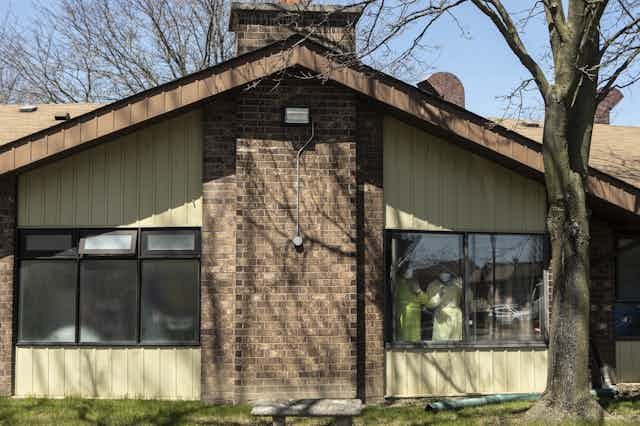Nationwide, long-term care facilities, primarily occupied by residents who are elderly or live with disabilities, are in deteriorating condition. But little has been done to actually address the organizational decisions that lead to these dangerous conditions. COVID-19 has exposed many inequities within Canada’s care systems.
When we look at who is disproportionately affected by this pandemic, we can’t help but ask how ableism shapes notions of whose lives are valued and whose are not. As governments plan for a “return to normal” while serious systemic issues remain in long-term living facilities, is normal really what we want to return to?
Localized, facility-based outbreaks of the coronavirus have led to high numbers of residents and staff contracting COVID-19. More than 40 per cent of the residents of Pinecrest Nursing Home in Bobcaygeon, Ont., have lost their lives to COVID-19. Similar patterns have surfaced in British Columbia, other communities in Ontario, Alberta, Québec (most severely) and Nova Scotia.
This is also true in facilities dedicated to people with disabilities. A Markham, Ont., facility reported that 40 of 42 residents and 38 health-care workers tested positive for COVID-19 towards the end of April.

According to the Toronto Star, deaths of residents in long-term care facilities made up 82 per cent of the country’s total number of fatalities due to COVID-19 as of May 7, 2020. Despite the continuing threat of COVID-19 to residents in care facilities and warnings of a resurgence, many jurisdictions are now making plans to lighten travel and social restrictions.
Long-term care, long-term problems
Even before the pandemic, long-term care facilities had disturbing incidences of abuse, neglect and even murder. Yet the conditions that allow such atrocities to occur continue.
Long-term care facilities often experience severe deficits in funding and staff. Typically, there is far greater demand for beds than there are beds available, leaving no opportunity for choice of facility.
For many Canadians, the choice to move into residential care is not really a choice at all. There are limited options for many people who require around-the-clock care. Independent living centres are not broadly available and many have extensive waiting lists. Self-directed care options may be available, however, there are limitations for those who require full-time support.

These services are also vulnerable to staffing shortages, lack of training and funding cuts. While personal support workers (PSWs) provide a critical service and support many personal care activities for daily living, their work is often undervalued. Many are overworked, underpaid and precariously employed.
In addition, care work is often fulfilled through the labour of poor, racialized and/or immigrant women who may face additional barriers in drawing attention to exploitative working conditions. During the pandemic, it has been revealed that PSWs are not always provided with adequate personal protective equipment to keep themselves or the residents safe.
But none of this is new or, at least, unexpected. For generations, the dangers that arise when we organize populations into institutional settings have been abundantly clear. COVID-19 may have shone a spotlight on these issues, but the inequities were always there.
An indifference towards people with disabilities
At a March 23 news conference, Dr. Deborah Birx, the White House coronavirus response co-ordinator, spoke on the global mortality rates of COVID-19. She assured the public that the majority of people who do and will perish from the virus are largely elderly and those with pre-existing conditions.
“Still 99 per cent of all the mortality coming out of Europe, in general, is over 50 and pre-existing conditions. The pre-existing condition piece still holds in Italy with the majority of the mortality having three or more pre-existing conditions. I think this is reassuring to all of us, but it doesn’t change the need to continue to protect the elderly….”
Birx’s statement echoes a dangerous discourse that people with disabilities as well as disability activists and allies have been challenging for some time — an insidious indifference towards the lives of persons who are disabled or elderly.
To whom would this be reassuring? This casual and callous indifference has come further into focus as jurisdictions weigh the economic implications of returning to normal despite the continued, and possibly heightened, risk for persons in residential care.
Nirmala Erevelles, a critical disability studies scholar, explores the role capitalism and capitalist principles play in producing bodies that matter and bodies that do not. Ableism is keenly expressed by attempting to justify human value through the lens of economic productivity and perceived expense. As disability justice activist Mia Mingus writes: “Ableism is connected to all of our struggles because it undergirds notions of whose bodies are considered valuable, desirable and disposable.”
This crisis exposes how ableism has long shaped how we think about care and those who receive care. Ableism shapes how we organize long-term care funding, staffing and crisis management as well as day-to-day care.
As governments and organizations re-imagine how care can be more effectively delivered, there are lessons to be learned from people who have navigated care and service systems before the global crisis began. People with disabilities and those who have experienced life in long-term care need to be at the forefront, leading and advising on systemic change.

